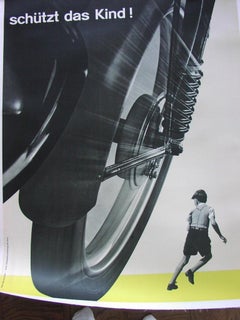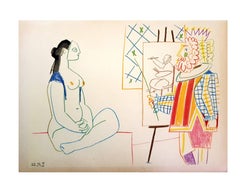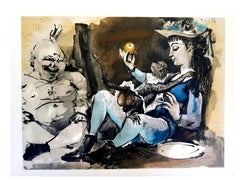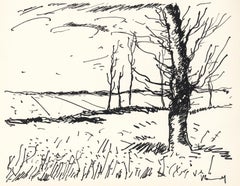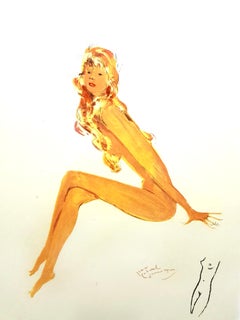1950s Figurative Prints
to
1,181
1,747
291
171
55
33
Overall Width
to
Overall Height
to
1,056
273
257
121
80
68
22
17
16
4
4
2
244
58
55
50
47
3,530
7,599
25,383
6,838
292
597
1,410
1,239
1,331
2,297
3,257
5,180
2,834
1,341
3,027
1,757
522
11
1,518
950
856
581
510
383
367
299
188
102
93
92
77
75
66
57
52
46
40
39
1,567
381
148
119
84
124
551
1,378
777
Period: 1950s
Domergue - Naked - Original Signed Lithograph
Located in Collonge Bellerive, Geneve, CH
Original Lithograph by Jean-Gabriel Domergue
Title: Naked
Signed
Dimensions: 40 x 31 cm
1956
Edition of 197
This artwork is part of the famous portfolio "La Parisienne"
Jean-Gabrie...
Category
Impressionist 1950s Figurative Prints
Materials
Lithograph
Schutzt Das Kind! Automobil-Club der Schweiz
By Muller-Brockmann, Josef.
Located in New York, NY
Muller-Brockmann, Josef. Schutzt Das Kind! Automobil-Club der Schweiz 1953. On linen
Offset. Minor imperfection otherwise in good condition
50 x 35 7/8".
Pioneer of Swiss Graphic...
Category
Modern 1950s Figurative Prints
Materials
Offset
The Human Comedy - Lithograph
Located in Collonge Bellerive, Geneve, CH
after Pablo Picasso - The Human Comedy - Lithograph
Signed and dated in the plate
Dimensions: 32 x 24 cm
This artwork is a lithograph in colors on wov...
Category
Modern 1950s Figurative Prints
Materials
Lithograph
The Human Comedy - Lithograph
Located in Collonge Bellerive, Geneve, CH
After Pablo Picasso
The Human Comedy - Lithograph after an original drawing, as published in the journal "Verve"
Printed signature and date
Dimensi...
Category
Modern 1950s Figurative Prints
Materials
Lithograph
Vlaminck, Vallee de l'Avre, Vlaminck (after)
Located in Southampton, NY
Lithograph on vélin paper. Inscription: Unsigned and unnumbered. Good condition. Notes: From the volume, Vlaminck, 1958; published by Éditions André Sauret, Paris, and Universe Books...
Category
Modern 1950s Figurative Prints
Materials
Lithograph
$716 Sale Price
20% Off
Domergue - Red Hair Elegance - Original Signed Lithograph
Located in Collonge Bellerive, Geneve, CH
Original Lithograph by Jean-Gabriel Domergue
Title: Red Hair Elegance
Signed in the plate
Dimensions: 40 x 31 cm
1956
Edition of 197
This artwork is part of the famous portfolio "La ...
Category
Impressionist 1950s Figurative Prints
Materials
Lithograph
JUGGLER
Located in Portland, ME
Marini, Marino. JUGGLER. San Lazzarro Etcing no 35. Etching, 1954.
Edition of 65, from the album of 23 etchings published by Crommelynck
in 1970. Numbered 62/65 and signed in pencil...
Category
1950s Figurative Prints
Materials
Etching
"Noel, " Religious Linocut in Blue on Tissue Paper signed by Sylvia Spicuzza
Located in Milwaukee, WI
"Noel" is an original linocut on tissue paper by Sylvia Spicuzza. The artist stamped her signature lower right. This artwork features the Virgin Mary holding the baby Jesus. Both fig...
Category
American Modern 1950s Figurative Prints
Materials
Linocut
Scène XX, Shakespeare, Macbeth, Eaux-fortes de Gromaire
Located in Southampton, NY
Etching on Vélin de Rives paper. Unsigned and unnumbered, as issued. Good condition. Notes: From the folio, Shakespeare, Macbeth, Eaux-fortes de Gromaire, 1958. Published by Tériade,...
Category
Modern 1950s Figurative Prints
Materials
Etching
$3,996 Sale Price
20% Off
Scène XX, Shakespeare, Macbeth, Eaux-fortes de Gromaire
Located in Southampton, NY
Etching on Vélin de Rives paper. Unsigned and unnumbered, as issued. Good condition. Notes: From the folio, Shakespeare, Macbeth, Eaux-fortes de Gromaire, 1958. Published by Tériade,...
Category
Modern 1950s Figurative Prints
Materials
Etching
$3,996 Sale Price
20% Off
Scène IX, Shakespeare, Macbeth, Eaux-fortes de Gromaire
Located in Southampton, NY
Etching on Vélin de Rives paper. Unsigned and unnumbered, as issued. Good condition. Notes: From the folio, Shakespeare, Macbeth, Eaux-fortes de Gromaire, 1958. Published by Tériade,...
Category
Modern 1950s Figurative Prints
Materials
Etching
$3,996 Sale Price
20% Off
David and Bathsheba, from: The Bible - Judaica David and Bathsheba Unique
By Marc Chagall
Located in London, GB
This original etching is hand-coloured by the artist in yellow, orange and green watercolour.
It is signed in pencil "M. Ch." in the lower right margin.
It is numbered in pencil fr...
Category
Modern 1950s Figurative Prints
Materials
Watercolor, Etching
Trío Maya (Mayan Trio)
Located in New York, NY
A very good impression of this lithograph. From the edition of 250. Signed in pencil by Dosamantes. Published by Associated American Artists...
Category
Modern 1950s Figurative Prints
Materials
Lithograph
MY BELOVED
Located in Portland, ME
Barton, John Murray. MY BELOVED. Color Woodcut, 1958. Edition of 125. Titled, numbered 1/125, signed and dated in pencil. 23 5/8 x 7 3/4 inches (image), 11 1/2 x 27 inches (sheet). I...
Category
1950s Figurative Prints
Materials
Color, Woodcut
Ex Libris - Liba Zaleska - Woodcut - 1950s
Located in Roma, IT
Ex Libris - Liba Zaleska is an Artwork realized in 1950s.
Woodcut print on paper.
The work is glued on pink cardboard.
Total dimensions: 19.5 x 14.5 cm.
Good conditions.
The art...
Category
Modern 1950s Figurative Prints
Materials
Woodcut
Ex Libris - Lévy - Woodcut by Émilien Dufour - 1954
Located in Roma, IT
Ex Libris - Lévy is an Artwork realized in 1954, by the French Artist Émilien Dufour (1894-1975).
Lithograph on paper. Signed on plate and dated on the right margin.
The work is ...
Category
Modern 1950s Figurative Prints
Materials
Woodcut
Ex Libris - Herbert Ott - woodcut by Stanislaw Jakubowski - 1950s
Located in Roma, IT
Ex Libris - Herbert Ott is an Artwork realized in 1950 s. by the Polish Artist Stanislaw Jakubowski (1885-1964)
Etching print on ivory paper. Hand Signed on back.
The work is glue...
Category
Modern 1950s Figurative Prints
Materials
Woodcut
Ex Libris - Dit is Marieke's Boek - Woodcut - 1952
Located in Roma, IT
Ex Libris - Dit is Marieke's Boek is an Artwork realized in 1952.
Woodcut B./W. print on ivory paper.
The work is glued on colored cardboard.
Total dimensions: 11x15 cm.
Good co...
Category
Modern 1950s Figurative Prints
Materials
Woodcut
Ex Libris - V. Martinez Yuste - Woodcut - 1950s
Located in Roma, IT
Ex Libris - V. Martinez Yuste is an Artwork realized in 1950s, by the artist Herbert Ott.
Woodcut print on paper. M...
Category
Modern 1950s Figurative Prints
Materials
Woodcut
Ex Libris - Flowers - Woodcut by Frantisek Kobliha - 1951
Located in Roma, IT
Ex Libris - Flowers is an Artwork realized in 1951, by the artist Frantisek Kobliha (1877-1962).
Woodcut print on ivory paper....
Category
Modern 1950s Figurative Prints
Materials
Woodcut
Ex-Libris - J. Mercier - Woodcut by Jocelyn Mercier - 1957
Located in Roma, IT
Ex-Libris - J. Mercier is an Artwork realized in 1957, by the artist Jocelyn Mercier.
Woodcut print on paper. Signed on plate on back, numbered ex. 25.
The work is glued on card...
Category
Modern 1950s Figurative Prints
Materials
Woodcut
Sidereus Nuncius - Etching by Pierre-Yves Trémois - 1955
Located in Roma, IT
Le Messager Sidéral (Sidereus Nuncius) is an etching on paper, realized in 1955 by the French artist Pierre-Yves Trémois (Paris, 1921).
From Edition of 140 copies of the Suite "Cyn...
Category
Contemporary 1950s Figurative Prints
Materials
Etching
Jacob, Le vin de la Cène, Vins, Fleurs et Flammes (after)
Located in Southampton, NY
Lithograph and Stencil on grand vélin d'Arches spécial paper. Unsigned and unnumbered, as issued. Good condition. Notes: From the volume, Vins, Fleurs et Flammes, 1956. Published by ...
Category
Modern 1950s Figurative Prints
Materials
Lithograph, Stencil
$1,036 Sale Price
20% Off
After Pablo Picasso - Wildlife of Antibes - Lithograph
Located in Collonge Bellerive, Geneve, CH
After Pablo PICASSO (1881-1973)
One plate from the book: Jaime Sabartés. "Faunes et flore d'Antibes" (Greenwich, Conn: New York Graphic Society, 1960).
Color Lithograph
63 x 47 cm
...
Category
Modern 1950s Figurative Prints
Materials
Lithograph
after Jean Arp - Moustaches et Squelette - Pochoir
By Jean Arp
Located in Collonge Bellerive, Geneve, CH
after Jean Arp
Moustaches et Squelette
Executed in 1957 after the original artwork by the studios from Daniel Jacomet in Paris, France
Pochoir
Dimensions: 32 x 24 cm
From the art re...
Category
Surrealist 1950s Figurative Prints
Materials
Stencil, Paper
Jean Cocteau - Surrealist Smile - Original Lithograph
By Jean Cocteau
Located in Collonge Bellerive, Geneve, CH
Original Lithograph by Jean Cocteau
Title: Surrealist Smile
Signed in the plate
Dimensions: 32 x 25.5 cm
Edition: 200
1959
Publisher: Bibliophiles Du Palais
Unnumbered as issued
Category
Modern 1950s Figurative Prints
Materials
Lithograph
Derain, Composition, Derrière le miroir (after)
By André Derain
Located in Southampton, NY
Lithograph on vélin paper. Inscription: Unsigned and unnumbered, as issued. Good condition. Notes: From Derrière le miroir, N° 94-95, 1957. Published by Aimé Maeght, Éditeur, Paris; ...
Category
Modern 1950s Figurative Prints
Materials
Lithograph
$716 Sale Price
20% Off
Derain, Composition, Derrière le miroir (after)
By André Derain
Located in Southampton, NY
Lithograph on vélin paper. Inscription: Unsigned and unnumbered, as issued. Good condition. Notes: From Derrière le miroir, N° 94-95, 1957. Published by Aimé Maeght, Éditeur, Paris; ...
Category
Modern 1950s Figurative Prints
Materials
Lithograph
$716 Sale Price
20% Off
Derain, Composition, Derrière le miroir (after)
By André Derain
Located in Southampton, NY
Lithograph on vélin paper. Inscription: Unsigned and unnumbered, as issued. Good condition. Notes: From Derrière le miroir, N° 94-95, 1957. Published by Aimé Maeght, Éditeur, Paris; ...
Category
Modern 1950s Figurative Prints
Materials
Lithograph
$716 Sale Price
20% Off
Harmonies - Platonism - Etching by Pierre-Yves Trémois - 1955
Located in Roma, IT
Harmonies - Platonism is an etching on paper, realized in 1955 by the French artist Pierre-Yves Trémois (Paris, 1921).
From Edition of 140 copies of the Suite "Cynégétique".
Intro...
Category
Contemporary 1950s Figurative Prints
Materials
Etching
Copernic and Kepler - Etching by Pierre-Yves Trémois - 1955
Located in Roma, IT
Alchimie du Monde is an etching on paper, realized in 1955 by the French artist Pierre-Yves Trémois (Paris, 1921).
From Edition of 140 copies of the Suite "Cynégétique".
Introduct...
Category
Contemporary 1950s Figurative Prints
Materials
Etching
Fiat Lux- Etching by Pierre-Yves Trémois - 1955
Located in Roma, IT
Fiat Lux is an etching on paper, realized in 1955 by the French artist Pierre-Yves Trémois (Paris, 1921).
From Edition of 140 copies of the Suite "Cynégétiqu...
Category
Contemporary 1950s Figurative Prints
Materials
Etching
Jean Cocteau - Reflections - Original Lithograph
By Jean Cocteau
Located in Collonge Bellerive, Geneve, CH
Original Lithograph by Jean Cocteau
Title: Reflections
Signed in the plate
Dimensions: 32 x 25.5 cm
Edition: 200
1959
Publisher: Bibliophiles Du Palais
Unnumbered as issued
Category
Modern 1950s Figurative Prints
Materials
Lithograph
On Tips - Etching by Suzanne Tourte - 1951
Located in Roma, IT
On tips is an artwork realized by Suzanne Tourte in 1951.
Etching, 33 x 24 cm.
Hand signed and dated in the right left.
Good conditions, exept some ...
Category
Modern 1950s Figurative Prints
Materials
Etching
Marino Marini - Horses - Original Lithograph
Located in Collonge Bellerive, Geneve, CH
Marino Marini - Horses - Original Lithograph
1951
Dimensions: 32 x 24 cm
From the art review XXe siècle
Unsigned and unumbered as issued
Category
Surrealist 1950s Figurative Prints
Materials
Lithograph
Jean Cocteau - Surrealist Creature - Original Lithograph
By Jean Cocteau
Located in Collonge Bellerive, Geneve, CH
Original Lithograph by Jean Cocteau
Title: Surrealist Creature
Signed in the plate
Dimensions: 32 x 25.5 cm
Edition: 200
1959
Publisher: Bibliophiles Du Palais
Unnumbered as issued
Category
Modern 1950s Figurative Prints
Materials
Lithograph
Star of the Sea Étoile de mer - German French Star of the Sea
By Max Ernst
Located in London, GB
This original lithograph in colours is hand signed by the artist "max ernst" at the lower right margin.
It is also hand numbered in pencil, from the edition of 200, at the lower left...
Category
Surrealist 1950s Figurative Prints
Materials
Lithograph
Ex Libris - Vivian V.D. Hoog - Woodcut by Richard Lancelot - 1950s
Located in Roma, IT
Ex Libris - Vivian V.D. Hoog is a Modern Artwork realized in Mid 20th Century, by Richard Lancelot, from Nederland.
Ex Libris. B/W woodcut on ivory paper. Hand signed on the bac...
Category
Modern 1950s Figurative Prints
Materials
Woodcut
Ex Libris - Woodcut by Frans Lasure - 1956
Located in Roma, IT
Ex-Libris - F. Lasure is an Artwork realized in 1956 by the Belgian Author Frans Lasure.
Woodcut B./W. print on paper. Signed on plate and dated on the back.
The work is glued on c...
Category
Modern 1950s Figurative Prints
Materials
Woodcut
Don Quixote Watching Nude - Etching by Wladyslaw Jahl - 1951
Located in Roma, IT
Don Quixote Watching Nude is an etching and drypoint print on ivory-colored Japanese paper, realized by Wladyslaw Jahl in 1951.
It belongs to a limited edition of 125 specimens.
Go...
Category
Contemporary 1950s Figurative Prints
Materials
Etching
Don Quixote in The Bed - Etching by Wladyslaw Jahl - 1951
Located in Roma, IT
Don Quixote in The Bed is an etching and drypoint print on ivory-colored Chinese paper, realized by Wladyslaw Jahl in 1951.
It belongs to a limited edition of 125 specimens.
Good c...
Category
Contemporary 1950s Figurative Prints
Materials
Etching
Speech of Don Quixote - Etching by Wladyslaw Jahl - 1951
Located in Roma, IT
Speech of Don Quixote is an etching and drypoint print on ivory-colored China paper, realized by Wladyslaw Jahl in 1951.
It belongs to a limited edition of 125 specimens.
Good cond...
Category
Contemporary 1950s Figurative Prints
Materials
Etching
Don Quixote in The Bed - Etching by Wladyslaw Jahl - 1951
Located in Roma, IT
Don Quixote in The Bed is an etching and drypoint print on ivory-colored Japanese paper, realized by Wladyslaw Jahl in 1951.
It belongs to a limited edition of 125 specimens.
Good...
Category
Contemporary 1950s Figurative Prints
Materials
Etching
Don Quixote and Women - Etching by Wladyslaw Jahl - 1951
Located in Roma, IT
Don Quixote and Women is an etching and drypoint print on ivory-colored Japanese paper, realized by Wladyslaw Jahl in 1951.
It belongs to a limited edition of 125 specimens.
Good c...
Category
Contemporary 1950s Figurative Prints
Materials
Etching
Jean Cocteau - Woman Portrait - Original Lithograph
By Jean Cocteau
Located in Collonge Bellerive, Geneve, CH
Original Lithograph by Jean Cocteau
Title: Woman Portrait
Signed in the plate
Dimensions: 32 x 25.5 cm
Edition: 200
1959
Publisher: Bibliophiles Du Palais
Unnumbered as issued
Category
Modern 1950s Figurative Prints
Materials
Lithograph
The Procession for Don Quixote - Etching by Wladyslaw Jahl - 1951
Located in Roma, IT
The Procession for Don Quixote is an etching and drypoint print on ivory-colored China paper, realized by Wladyslaw Jahl in 1951.
It belongs to a limit...
Category
Contemporary 1950s Figurative Prints
Materials
Etching
Composition, Cirque (Saphire, N° 44-106)
Located in Southampton, NY
Lithograph on vélin d’Arches paper. Inscription: Unsigned and unnumbered, as issued. Good condition. Notes: From the folio, Cirque, Lithographies Originales. Published by Les Éditions Verve, Paris, under the direction of Tériade, éditeur, Paris; printed by Mourlot Frères, Paris, October 5, 1950. Excerpted from the folio (translated from French), "Cirque" is entirely composed, handwritten text and illustrations, of original lithographs by Fernand Léger. This album was produced by Fernand Léger with the collaboration of Tériade and Marguerite Lang. It was completed printing on the presses de Mourlot Frères, on October 5, 1950, for Les Éditions Verve, Paris. The edition of this album includes two CCLXXX examples numbered from I to CCLXXX and XX hors-commerce examples. Numbered from I to XX. All examples, on vélin d'Arches, are signed by the artist [on the colophon].
Catalogue raisonné reference: Léger, F., & Saphire, L. (1978). Fernand Léger : the complete graphic work. Blue Moon Press, 44-106.
History of the edition: Cirque was originally conceived as a collaboration between Fernand Léger and the novelist Henry Miller. At a time when the two were interested in working together, the publisher Efstratios Tériade Léger approached Leger to make prints for an artist’s book. Tériade hoped to publish a series of such books with the circus as the theme. Léger was a circus enthusiast who often used circus images in his paintings. He often went to the Cirque Médrano in Paris and the Ringling Brothers and Barnum and Bailey Circus...
Category
Modern 1950s Figurative Prints
Materials
Lithograph
$1,996 Sale Price
37% Off
Composition, Cirque (Saphire, N° 44-106)
Located in Southampton, NY
Lithograph on vélin d’Arches paper. Inscription: Unsigned and unnumbered, as issued. Good condition. Notes: From the folio, Cirque, Lithographies Originales. Published by Les Édition...
Category
Modern 1950s Figurative Prints
Materials
Lithograph
$1,996 Sale Price
37% Off
Composition, Cirque (Saphire, N° 44-106)
Located in Southampton, NY
Lithograph on vélin d’Arches paper. Inscription: Unsigned and unnumbered, as issued. Good condition. Notes: From the folio, Cirque, Lithographies Originales. Published by Les Édition...
Category
Modern 1950s Figurative Prints
Materials
Lithograph
$1,996 Sale Price
20% Off
Composition, Cirque (Saphire, N° 44-106)
Located in Southampton, NY
Lithograph on vélin d’Arches paper. Inscription: Unsigned and unnumbered, as issued. Good condition. Notes: From the folio, Cirque, Lithographies Originales. Published by Les Édition...
Category
Modern 1950s Figurative Prints
Materials
Lithograph
$1,996 Sale Price
20% Off
Composition, Cirque (Saphire, N° 44-106)
Located in Southampton, NY
Lithograph on vélin d’Arches paper. Inscription: Unsigned and unnumbered, as issued. Good condition. Notes: From the folio, Cirque, Lithographies Originales. Published by Les Éditions Verve, Paris, under the direction of Tériade, éditeur, Paris; printed by Mourlot Frères, Paris, October 5, 1950. Excerpted from the folio (translated from French), "Cirque" is entirely composed, handwritten text and illustrations, of original lithographs by Fernand Léger. This album was produced by Fernand Léger with the collaboration of Tériade and Marguerite Lang. It was completed printing on the presses de Mourlot Frères, on October 5, 1950, for Les Éditions Verve, Paris. The edition of this album includes two CCLXXX examples numbered from I to CCLXXX and XX hors-commerce examples. Numbered from I to XX. All examples, on vélin d'Arches, are signed by the artist [on the colophon].
Catalogue raisonné reference: Léger, F., & Saphire, L. (1978). Fernand Léger : the complete graphic work. Blue Moon Press, 44-106.
History of the edition: Cirque was originally conceived as a collaboration between Fernand Léger and the novelist Henry Miller. At a time when the two were interested in working together, the publisher Efstratios Tériade Léger approached Leger to make prints for an artist’s book. Tériade hoped to publish a series of such books with the circus as the theme. Léger was a circus enthusiast who often used circus images in his paintings. He often went to the Cirque Médrano in Paris and the Ringling Brothers and Barnum and Bailey Circus...
Category
Modern 1950s Figurative Prints
Materials
Lithograph
$1,996 Sale Price
20% Off
Flor y el Viejo - Etching and Drypoint by Wladyslaw Jahl - 1951
Located in Roma, IT
Flor y el Vejo is an etching and drypoint print on ivory-colored Japanese paper, realized by Wladyslaw Jahl in 1951.
It belongs to a limited edition of 125 specimens.
Good conditio...
Category
Contemporary 1950s Figurative Prints
Materials
Etching
Don Quixote and the Women - Etching and Drypoint by Wladyslaw Jahl - 1951
Located in Roma, IT
Don Quixote and the Women is anetching and drypoint print on ivory-colored China paper, realized by Wladyslaw Jahl in 1951.
It belongs to a limited edition of 125 specimens.
Good c...
Category
Contemporary 1950s Figurative Prints
Materials
Etching
Flor y el Vejo - Etching and Drypoint by Wladyslaw Jahl - 1951
Located in Roma, IT
Flor y el Vejo is an etching and drypoint print on ivory-colored China paper, realized by Wladyslaw Jahl in 1951.
It belongs to a limited edition of 125 specimens.
Good conditions....
Category
Contemporary 1950s Figurative Prints
Materials
Etching
The Departure of Don Quixote - Etching and Drypoint by Wladyslaw Jahl - 1951
Located in Roma, IT
The Departure Don Quixote is an etching and drypoint print on ivory-colored China paper, realized by Wladyslaw Jahl in 1951.
It belongs to a limited edition of 125 specimens.
Good ...
Category
Contemporary 1950s Figurative Prints
Materials
Etching
Don Quixote and Sancho Panza - Etching by Wladyslaw Jahl - 1951
Located in Roma, IT
Don Quixote and Sancho Panza is an etching and drypoint print on ivory-colored China paper, realized by Wladyslaw Jahl in 1951.
It belon...
Category
Contemporary 1950s Figurative Prints
Materials
Etching
Don Quixote and Sancho Panza - Etching by Wladyslaw Jahl - 1951
Located in Roma, IT
Don Quixote and Sancho Panza is an etching and drypoint print on ivory-colored China paper, realized by Wladyslaw Jahl in 1951.
It belong...
Category
Contemporary 1950s Figurative Prints
Materials
Etching
Don Quixote Galloping - Etching and Drypoint by Wladyslaw Jahl - 1951
Located in Roma, IT
Don Quixote Galloping is an etching and drypoint print on ivory-colored Japanese paper, realized by Wladyslaw Jahl in 1951.
It belongs to a limited edition of 125 specimens.
Good c...
Category
Contemporary 1950s Figurative Prints
Materials
Etching
The Arrival of Don Quixote - Etching and Drypoint by Wladyslaw Jahl - 1951
Located in Roma, IT
The Arrival of Don Quixote is an etching and drypoint print on ivory-colored Japanese paper, realized by Wladyslaw Jahl in 1951.
It belongs to a limited edition of 125 specimens.
G...
Category
Contemporary 1950s Figurative Prints
Materials
Etching
The Meeting - Etching by Wladyslaw Jahl - 1951
Located in Roma, IT
The Meeting is an etching and drypoint print on ivory-colored China paper, realized by Wladyslaw Jahl in 1951 for the Suite Don Quixote.
They belong to a limited edition of 125 spec...
Category
Contemporary 1950s Figurative Prints
Materials
Etching
Recently Viewed
View AllMore Ways To Browse
Kim Tschang Yeul
Tom Blackwell On Sale
Tom Everhart Lithograph
Torii Kotondo
Victor Richardson
Vintage Boulangerie Signs
Vintage Les Nereides
Vintage Meat Scales
Vintage Multiplier Reel
Warhol Northwest Mask
Whistler Fumette
Yoko Ono Lithograph Harold Town
Zeno Giglietti
Ak47 Lotus
Alex Katz Bicycle
Alex Katz Christy
Alex Katz Twilight
Alex Katz Wedding Dress

